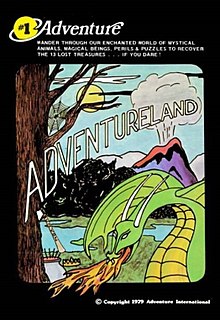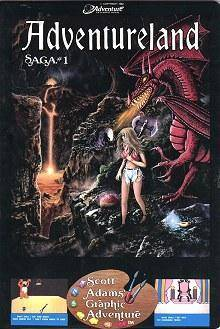Interactive fiction, often abbreviated IF, is software simulating environments in which players use text commands to control characters and influence the environment. Works in this form can be understood as literary narratives, either in the form of Interactive narratives or Interactive narrations. These works can also be understood as a form of video game, either in the form of an adventure game or role-playing game. In common usage, the term refers to text adventures, a type of adventure game where the entire interface can be "text-only", however, graphical text adventure games, where the text is accompanied by graphics still fall under the text adventure category if the main way to interact with the game is by typing text. Some users of the term distinguish between interactive fiction, known as "Puzzle-free", that focuses on narrative, and "text adventures" that focus on puzzles.

Zork is a text-based adventure game first released in 1977 by developers Tim Anderson, Marc Blank, Bruce Daniels, and Dave Lebling for the PDP-10 mainframe computer. The original developers and others, as the company Infocom, expanded and split the game into three titles—Zork I: The Great Underground Empire, Zork II: The Wizard of Frobozz, and Zork III: The Dungeon Master—which were released commercially for a range of personal computers beginning in 1980. In Zork, the player explores the abandoned Great Underground Empire in search of treasure. The player moves between the game's hundreds of locations and interacts with objects by typing commands in natural language that the game interprets. The program acts as a narrator, describing the player's location and the results of the player's commands. It has been described as the most famous piece of interactive fiction.
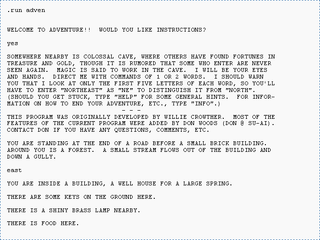
Colossal Cave Adventure is a text-based adventure game, released in 1976 by developer Will Crowther for the PDP-10 mainframe computer. It was expanded upon in 1977 by Don Woods. In the game, the player explores a cave system rumored to be filled with treasure and gold. The game is composed of dozens of locations, and the player moves between these locations and interacts with objects in them by typing one- or two-word commands which are interpreted by the game's natural language input system. The program acts as a narrator, describing the player's location and the results of the player's attempted actions. It is the first well-known example of interactive fiction, as well as the first well-known adventure game, for which it was also the namesake.

Scott Adams is an American entrepreneur, computer programmer, and video game designer. He co-founded, with then-wife Alexis, Adventure International in 1979. The company developed and published video games for home computers. The cornerstone products of Adventure International in its early years were the Adventure series of text adventures written by Adams.
Questprobe is a trilogy of graphical adventure video games featuring Marvel Comics characters. The three games are Questprobe featuring The Hulk, Questprobe featuring Spider-Man and Questprobe featuring Human Torch and Thing.
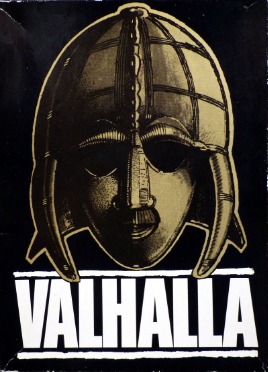
Valhalla is a text adventure with graphics published in 1983 by the British studio Legend for the ZX Spectrum. It reached number one in the UK sales charts. The Commodore 64 version of the game was released in 1984 and reached number five.

Colossal Adventure is a text based adventure game published by Level 9 Computing in 1982. It was originally released for the Nascom.

Questprobe: Featuring Spider-Man is the second video game in the Questprobe series.
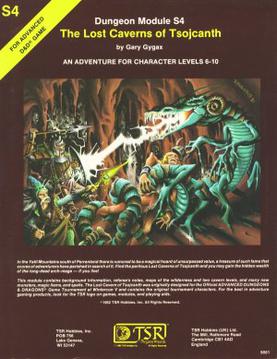
The Lost Caverns of Tsojcanth is an adventure module for the Dungeons & Dragons fantasy role-playing game. It was written by Gary Gygax and published by TSR in 1982 for the first edition Advanced Dungeons & Dragons (AD&D) rules. The 64-page adventure bears the code "S4" and is set in the Greyhawk campaign setting. It is divided into two parts, a 32-page adventure, and a 32-page booklet of monsters and magic items. The plot involves the player characters investigating rumors of lost treasure. After traversing a wilderness and two levels of dungeons, the players face Drelnza, the vampiric daughter of long-deceased archmage Iggwilv.

Pirate Adventure is a text adventure program written by Scott Adams.
Brian Howarth is a British video game designer and computer programmer. He wrote many interactive fiction computer games in the early 1980s in a series called Mysterious Adventures. He was born in Blackpool in 1953.
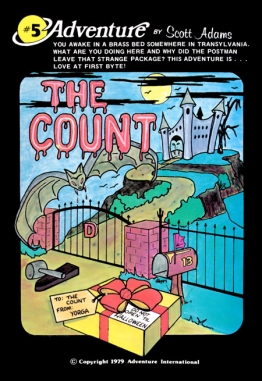
The Count is a text adventure written by Scott Adams and published by Adventure International in 1979. The player character has been sent to defeat the vampire Count Dracula by the local Transylvanian villagers, and must obtain and use items from around the vampire's castle in order to defeat him.

Strange Odyssey is a text adventure written by Scott Adams and Neil Broome.

Mystery Fun House is a text adventure game written by Scott Adams, "Adventure 7" in the series released by Adventure International. The player explores a fun house explore to locate a set of secret plans, solving puzzles along the way. Mystery Fun House was produced in only one week and was among the most difficult games in the series.

Questprobe featuring The Hulk is a 1984 graphic adventure video game developed and published by Adventure International in collaboration with Marvel Comics. It is the first entry in Questprobe, an intended series of graphic adventure games that only released three installments before the developer's bankruptcy. The game's narrative follows the Marvel superhero Hulk and his human alter-ego Bruce Banner, who must explore the mysterious lair of the Chief Examiner. The graphics and story outline were created by Marvel artists and writers. Critical reception was generally positive, with much of the praise going to the visuals. Reactions to the gameplay were mixed, especially upon the game's budget re-release, by which time it was considered dated.
Adventure International was an American video game publishing company that existed from 1979 until 1986. It was started by Scott and Alexis Adams. Their games were notable for being the first implementation of the adventure genre to run on a microcomputer system. The adventure game concept originally came from Colossal Cave Adventure which ran strictly on large mainframe systems at the time.

Time Traveler is a 1980 fantasy text adventure developed by Krell Software. The game was released on the 16K, Level II TRS-80, Apple II, Commodore PET, and Atari 8-bit family
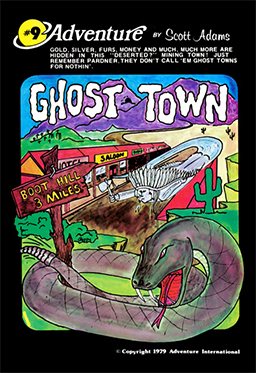
Ghost Town is a text adventure developed by Adventure International and released in 1980. It is part of the Adventure series of games developed by Scott Adams, preceded by Adventureland, Pirate Adventure, and Strange Odyssey.
An adventure game is a video game genre in which the player assumes the role of a protagonist in an interactive story, driven by exploration and/or puzzle-solving. The genre's focus on story allows it to draw heavily from other narrative-based media, such as literature and film, encompassing a wide variety of genres. Most adventure games are designed for a single player, since the emphasis on story and character makes multiplayer design difficult. Colossal Cave Adventure is identified by Rick Adams as the first such adventure game, first released in 1976, while other notable adventure game series include Zork, King's Quest, Monkey Island, Syberia, and Myst.
